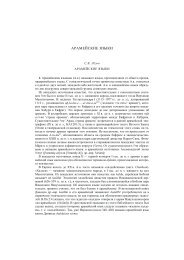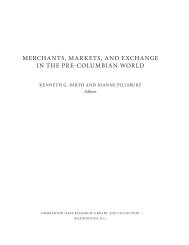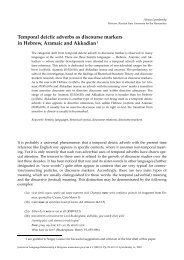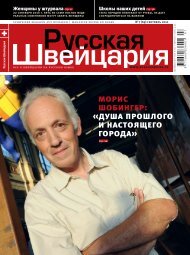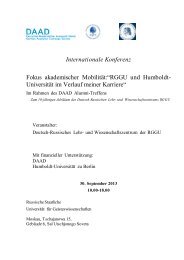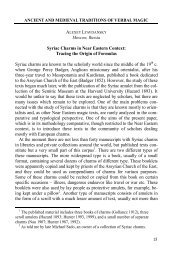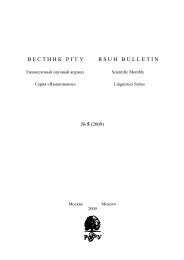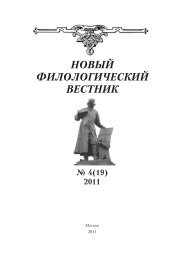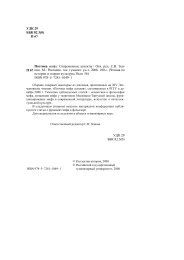Akkadian Sentences about the Present Time (II/2)
Akkadian Sentences about the Present Time (II/2)
Akkadian Sentences about the Present Time (II/2)
You also want an ePaper? Increase the reach of your titles
YUMPU automatically turns print PDFs into web optimized ePapers that Google loves.
764 Morphosyntax and Text Structure in <strong>Akkadian</strong>(38) kullumum ‘to show; to assign’To code <strong>the</strong> Experiencer, i. e., <strong>the</strong> one to whom something is shown, assigned,etc., <strong>the</strong> prefixing tenses use <strong>the</strong> acc.: ÍD GN li-ka-al-li-mu-ka ‘let<strong>the</strong>m show you <strong>the</strong> Gabûm canal’ (AbB 4, 74:10f.). In all <strong>the</strong> attestedcases from OB letters, <strong>the</strong> SC is P, with <strong>the</strong> Experiencer as <strong>the</strong> syntacticsubject: (1) itâm ša kirîm ša ibaššû išariš ul ku-ul-lu-ma-nu ‘We have notbeen properly shown <strong>the</strong> existing boundary of that garden’ (AbB 14,91:28f.); (2) ittī-kunu bā!erūtam e[pē]šam ku-ul-lu-mu-ma taprik-am-ma anabā!erūtim epēšim [ul t]addin-aššunūti ‘They have been assigned to do <strong>the</strong>fishing with you, but you were a hindrance and did not allow <strong>the</strong>m to do<strong>the</strong> fishing. < Let <strong>the</strong>m (now) do <strong>the</strong> fishing!>’ (AbB 11, 112:18–22,Stol’s translation); (3) kīma šattišam ku-ul-lu-ma-ta ‘As you experience eachyear’ (AbB 7, 169:9f.), 12 (4) kīma ištu labirtim É-ti na-ap-¢a-ri-ia šisâm uaītam lā ku-ul-lu-mu ul tīde ‘Do you not know that from of old my guesthousehas never been “shown” summons and extraordinary duties?’ (AbB2, 97:1–5, cf. CAD K 523a). The SC P appears a few more times in stereotypedadverbial kīma-clauses: ‘have votive gifts made kīma ku-ul-lu-ma-ta asyou have been assigned’ (AbB 9, 182:22), ‘<strong>the</strong> rites of <strong>the</strong> seventh day,kīma ku-ul-lu-ma-a-ta as you have been instructed, perform!’ (AbB 14,50:10′), ‘bring garlic and onions kīma ku-ul-lu-mu as it has been prescribed’(AbB 2, 99:14). 13 These are all <strong>the</strong> examples in OB letters I amaware of. One token is known from an OB physiognomic text: šummaawīlum pa-ga-ar ši-ru-šu pū´am ku-ul-lu-u[m]-ma u nu-uq-di itaddu ‘if a man’sbody/flesh 14 shows white spot(s) and is dotted with nuqdu-marks’ (AfO 18,66:42). 15 A syntactic analogy with <strong>the</strong> letters allows one to interpret <strong>the</strong>first clause of <strong>the</strong> protasis as ‘if his flesh is shown/assigned white spots’Afroasiatic grammatical reconstruction, <strong>the</strong>re can be no saying whe<strong>the</strong>r <strong>the</strong> Berberevidence reflects <strong>the</strong> situation in a Berber-Semitic proto-language.12Kraus translates ‘Wie du alljährlich hast erleben lassen,’ but without an (atleast implicit) personal object this translation does not really make much sense.Note that in AbB 7, 177:10 Kraus restores ki-ma ša-at-ti-ša-am ku-ul-l[u-ma-ta] ‘Wiedu alljährlich erlebst.’ This usage is passive, ‘you are shown.’13The last example is exceptional. If I understand it correctly, it does notquite belong here. The clause seems to be “impersonal,” as against kīma kullumāta‘you (ms) have been prescribed/told.’ In o<strong>the</strong>r words, <strong>the</strong> syntactic subject of thiskullumū is no Experiencer, but ra<strong>the</strong>r an unnamed Agent.14According to <strong>the</strong> Edition, pa-ga-ar ši-ru-šu ‘is a mistake of <strong>the</strong> scribe or agloss showing a variant from a duplicate.’15The translation “shows” appears both in <strong>the</strong> Edition (Köcher and Oppenheim)and CAD K 521.




